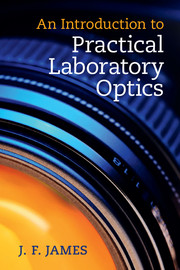Book contents
- Frontmatter
- Contents
- Preface
- 1 Introduction: centred optical systems
- 2 Telescopes and binoculars
- 3 Eyepieces, eyes and colour
- 4 Cameras and camera lenses
- 5 The scientific CCD camera
- 6 Spectrometry
- 7 Interferometers and their uses
- 8 Electro-optical effects and their practical uses
- 9 Microscopes and projectors
- 10 Siderostats and coelostats
- 11 The detection and measurement of radiation
- 12 Practicalities
- Appendix A Gaussian optics
- Appendix B Optical aberrations
- Appendix C A brief introduction to Fourier optics
- Further reading
- Index
1 - Introduction: centred optical systems
Published online by Cambridge University Press: 05 October 2014
- Frontmatter
- Contents
- Preface
- 1 Introduction: centred optical systems
- 2 Telescopes and binoculars
- 3 Eyepieces, eyes and colour
- 4 Cameras and camera lenses
- 5 The scientific CCD camera
- 6 Spectrometry
- 7 Interferometers and their uses
- 8 Electro-optical effects and their practical uses
- 9 Microscopes and projectors
- 10 Siderostats and coelostats
- 11 The detection and measurement of radiation
- 12 Practicalities
- Appendix A Gaussian optics
- Appendix B Optical aberrations
- Appendix C A brief introduction to Fourier optics
- Further reading
- Index
Summary
The common properties of optical instruments
Optical instruments come in all shapes and sizes, from fly-on-the-wall surveillance cameras to 10 metre segmented astronomical reflecting telescopes, and in shapes from microscopes to sextants to periscopes to spectrographs to cine-projectors.
Whatever their purpose, they all have two things in common.
(1) They are image-forming devices, intended to make a picture, to form an image of a luminous source. The image may be on a cinema screen, on a photographic emulsion, on a CCD surface or on the retina of an eye.
(2) They are, with one important exception, centred systems. That is to say they comprise a series of curved surfaces of transparent materials or reflecting materials or both. The centres of curvature of the various elements all lie on a straight line called the optic axis. Light passes from the object, through successive elements until it emerges to form an image.
This is a slight over-simplification of course. There are occasional plane reflectors along the path, as in a periscope for example, but these are for convenience rather than for any peculiar optical properties they possess.
Optical elements
There are four basic optical elements: the lens, the mirror, the diffraction grating and the prism. What follows now concerns the first two of these. The others have chapters of their own.
Information
- Type
- Chapter
- Information
- An Introduction to Practical Laboratory Optics , pp. 1 - 14Publisher: Cambridge University PressPrint publication year: 2014
